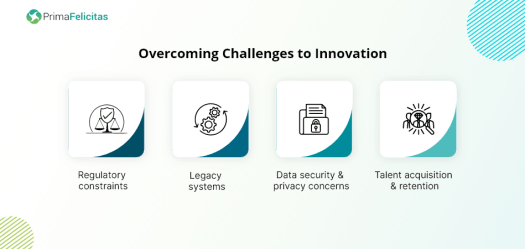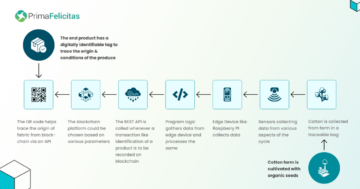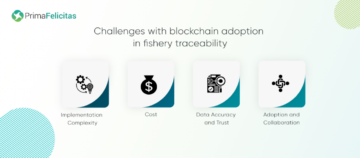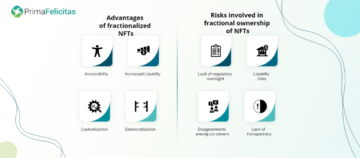Introduction
The financial services sector is amid a digital revolution, with fintech leading the way. How we handle money, investments, and transactions is undergoing a radical transformation driven by innovation. And traditional practices are giving way to disruptive technologies and forward-thinking solutions.
But it’s not just about technology. It’s about fostering a culture of constant improvement and diverse thinking. From the pivotal role of leadership to encouraging collaboration, creating an environment where innovation can flourish is critical.
In this post, we’ll explore innovation in the financial industry, why it’s necessary, and how to cultivate a culture that embraces it. We’ll also navigate the challenges posed by disruptive technologies, effective data management, and the hurdles companies must overcome to innovate successfully.
By the end, you’ll have the insights necessary to evaluate your company’s approach to innovation in a highly competitive industry.
Understanding the Role of Fintech in the Financial Services Industry
In the realm of time, it was a while ago when financial transactions required a visit to a brick-and-mortar bank, long lineups, and extensive paperwork. In fact, the first online banking service was introduced less than 30 years ago by Stanford Credit Union.
Since then, technology in banking has rapidly evolved. Banking has gone from tracking deposits and withdrawals by hand to accessing your entire financial portfolio in the palm of your hand. One illustrative example of fintech’s impact is the availability of software for financial advisors.
These software solutions testify to how technology drives innovation in the financial advisory sector. They empower financial advisors with once unimaginable tools, enabling them to provide more accurate and personalized guidance to their clients. Financial advisor software automates tasks, analyzes vast datasets in real time, and delivers insights previously only available to large financial institutions.
And it doesn’t stop there. Fintech has made its mark throughout the entire financial services industry. From mobile payment apps that allow you to split bills with friends effortlessly to peer-to-peer lending platforms that connect borrowers and investors directly, fintech innovations are making financial activities more efficient, convenient, and cost-effective.
One of the most disruptive fintech innovations in recent years is the advent of cryptocurrencies like Bitcoin. These digital currencies operate independently of traditional banks and have the potential to revolutionize how we think about money and finance. They promise faster, cheaper, and more accessible global transactions.
Fintech isn’t just about serving individuals. It’s also changing the way businesses manage their finances. Small and medium-sized enterprises (SMEs) can now access sophisticated accounting software, digital invoicing platforms, and online lending services that streamline their operations so they can thrive in a competitive market.
Fintech is breaking down barriers, making financial services more inclusive, and empowering individuals and businesses.
Strategies for Building a Culture of Innovation
Creating a culture of innovation is no simple undertaking. It requires careful planning and execution to facilitate an environment where you can embrace risk and celebrate creativity in your team members.
The following strategies will help you build a culture that inspires your workforce to think outside the box, challenge the status quo, and drive innovation to help your business grow and succeed.
Encourage a mindset of continuous improvement
Building a culture of innovation starts with encouraging your team to always look for better ways of doing things and being flexible in the face of change. But, this requires a mindset centered on continuous improvement and adaptability.
Instead of sticking to the same old routines and way of doing things, enable your employees to question the status quo. Give them the freedom to seek more efficient ways of doing things and get excited to share them with the team.
Instill the belief that complacency is the enemy of progress and that the pursuit of improvement is ongoing. When your team adopts this mindset, they become the driving force behind innovation, ensuring your organization remains at the forefront of industry advancements.
In the fast-paced world of financial services, where things can change in the blink of an eye, creating a culture that values learning and adapting is a game-changer. It means your organization will be ready to espouse new ideas and approaches, always staying ahead of the curve.
Promote diverse thinking and collaboration
Innovation doesn’t happen in a silo. Diverse thinking can be the catalyst that inspires the “next big thing.” When people with different backgrounds and experiences conspire, great solutions surface to the toughest problems.
For momentum to come from those relationships, it’s important that an organization be psychologically safe. In other words, people in the organization feel comfortable sharing their opinions, being transparent when times are good and bad, and knowing there aren’t any “stupid ideas.”
Cross-functional collaboration, where teams from various departments work together on projects, can spark fresh ideas. This collaboration creates opportunities for experts to share their knowledge and experiences and could lead to innovative solutions that solve complex problems.
Develop leaders who lead by example
Leadership plays a pivotal role in shaping and sustaining an innovative culture. Leaders set the tone, and their actions speak louder than words. When leaders prioritize innovation, allocate resources to support it, and lead by example, it sends a clear message to the entire organization.
Encouraging a culture of innovation means leaders must foster an environment where calculated risks are encouraged, and leadership sees failure as a stepping stone to success. In this environment, your leaders celebrate creativity because of the unique solutions it generates.
Work with, not against, your software engineers
Behind every new piece of software in your tech stack is a team of engineers doing their best to keep up. Although software engineers are at the forefront of fintech innovation, they are often relegated to the code they produce. But they’re people, too.
They’re dealing with the same problems all of us deal with outside of the workplace, and it’s essential you recognize them as individuals, accordingly, and check in to see how they’re doing and better yet, be liberal in your use of thank you when a job is done well.
Engineers are essential to your team and deserve recognition for their contributions. Motivating software engineers by providing opportunities for skill development and creating an environment where they can thrive should be part of your strategy to build a culture of innovation.
Embracing Disruptive Technologies
It started with the ATM in 1967. A machine that could accept paper checks and dispense cash made it faster and easier for workers to cash their checks. The invention of ATMs also opened up banking services to an entirely new customer base. They served a segment of people who couldn’t get to the bank during regular business hours.
ATM’s only got better, faster, cheaper to build and maintain, and more accessible with machines on every corner.
To this day, disruptive technologies like artificial intelligence (AI), blockchain, and the Internet of Things (IoT) are fundamentally reshaping the financial services industry. For instance, AI can analyze mountains of data and make more predictions in a week than a team of humans could make in a year.
This decision-making velocity enables financial institutions to develop products that are cheaper to produce and more accessible and affordable for consumers at unprecedented speeds.
Blockchain is like an ultra-secure digital ledger, reshaping how we handle transactions and making them more transparent and less reliant on intermediaries. And IoT solutions offer enhanced security and automated processes.
But there is a catch. Integrating these technologies can be challenging. Like learning anything new, it takes effort. There are hurdles like keeping data secure, respecting privacy, and getting everyone on the team up to speed with these new tools.
However, when financial companies welcome these technologies, they can make their operations smoother, cut costs, and serve customers better.
Visa exemplified this perfectly when they developed a way to spend money without cash. To this day, Visa remains at the forefront of disruptive technology with contactless payment and digital transactions.
Data Management and its Role in Innovation
Data management is the catalyst for innovation in the financial services industry. It provides your team with accurate information to make informed decisions, uncover hidden trends, and seize opportunities for improvement.
At its core, data management involves data collection, storage, organization, and utilization. It turns raw, disorganized data into actionable knowledge that helps bring new financial products or services to market efficiently and effectively.
Imagine attempting to develop a new product with scattered or outdated data. You’re bound to miss opportunities and waste valuable resources. However, with impeccable data, you can streamline the go-to-market (GTM) process. It also helps to remove barriers by addressing data privacy and security, integration, governance, and quality.
In the financial services industry and beyond, data management isn’t just about organizing information. It’s about unlocking the potential for groundbreaking ideas and solutions.
Overcoming Challenges to Innovation

The path to change is often overrun with obstacles. In the financial industry, a company’s willingness to overcome challenges can determine whether they are successful or struggles to remain relevant.
These challenges can be particularly difficult given the constraints of the industry and the constant need to be vigilant about compliance with regulations, rules, and structures that control the boundaries of the industry.
Here are several common roadblocks companies often encounter in their quest for innovation.
PrimaFelicitas is a well-known name in the market, serving worldwide consumers by delivering projects based on Web 3.0 technologies such as AI, Machine Learning, Blockchain and Cryptocurrency. Our expert team will serve you by turning your great ideas into innovative solutions.
Regulatory Constraints
Regulations in the financial sector are critical for maintaining stability and security. However, they can sometimes impede companies’ progress in seeking to pioneer new ideas. Successful financial companies have learned to navigate regulations by staying informed, collaborating closely with regulatory bodies, and proposing innovative solutions that comply with rules and push the boundaries of what’s possible.
Legacy systems
Legacy systems are the older, established technologies and processes deeply embedded within traditional financial institutions. Introducing innovation into these environments can be as challenging as fitting a square peg into a round hole. These outdated systems often need to be revised and can hinder the adoption of new, innovative solutions.
Luckily, innovative companies have found ways to work around this obstacle. They often opt for a phased approach, gradually integrating new technologies while ensuring compatibility with existing systems. It’s like renovating an old house, preserving what’s valuable, and updating what’s needed for modern living.
Data security and privacy concerns
The financial industry handles sensitive data, including personal and financial information. Innovations often involve collecting and processing more data, raising concerns about data security and privacy. Ensuring that customer data remains confidential and protected is a top priority, and any innovation must meet these stringent requirements.
Talent acquisition and retention
Attracting and retaining top talent in the highly competitive financial sector can be challenging. Financial institutions need skilled professionals with expertise in data science, artificial intelligence, and blockchain technology to drive innovation.
The demand for such talent often outpaces the supply, making talent acquisition and retention a significant hurdle. After all, the most talented people in niche industries like fintech often have access to the greatest diversity of choice regarding their next opportunity.
These additional challenges highlight the complexity of fostering innovation in the financial services industry. Addressing these issues requires strategic planning, adaptability, and a commitment to staying ahead in an ever-changing landscape.
The future of innovation
Creating a culture of innovation is critical for financial services to thrive in a fast-paced and competitive industry. It isn’t just a digital revolution — it’s about inspiring your team to think differently and challenge the status quo. They have to feel safe to press at the edges. To try and in some cases, to fail, as you find fresh solutions to lingering problems.
That level of creativity is much easier to foster when the organization is psychologically safe, and there’s a shared language and vision across the organization.
For best results, embrace disruptive technologies and be ready to navigate regulations with informed strategies, collaboration, and a dedication to progress.
Most importantly, remember that innovation is an ongoing commitment. To foster innovation within your organization, evaluate your culture, welcome change, and seek opportunities to leverage technology for positive change.
The future of financial services belongs to those willing to innovate, challenge convention, and continuously evolve.
Planning a Web 3.0 based Data centric Informed decision making project or wish to upgrade your existing Web 3.0 solution? Our expert team of professionals will assist you at every step of your Blockchain project development journey.
Post Views: 2
- SEO Powered Content & PR Distribution. Get Amplified Today.
- PlatoData.Network Vertical Generative Ai. Empower Yourself. Access Here.
- PlatoAiStream. Web3 Intelligence. Knowledge Amplified. Access Here.
- PlatoESG. Carbon, CleanTech, Energy, Environment, Solar, Waste Management. Access Here.
- PlatoHealth. Biotech and Clinical Trials Intelligence. Access Here.
- Source: https://www.primafelicitas.com/Insights/building-a-culture-of-innovation-in-the-financial-services-industry/?utm_source=rss&utm_medium=rss&utm_campaign=building-a-culture-of-innovation-in-the-financial-services-industry
- :has
- :is
- :not
- :where
- $UP
- 1
- 30
- 9
- a
- About
- Accept
- access
- accessible
- accessing
- accordingly
- Accounting
- accounting software
- accurate
- acquisition
- across
- actions
- activities
- adaptability
- adapting
- Additional
- addressing
- Adoption
- advancements
- advent
- advisor
- advisors
- advisory
- affordable
- After
- against
- ago
- ahead
- AI
- All
- allocate
- allow
- also
- Although
- always
- Amid
- an
- analyze
- analyzes
- and
- any
- anything
- approach
- approaches
- apps
- ARE
- around
- artificial
- artificial intelligence
- Artificial intelligence (AI)
- AS
- assist
- At
- ATM
- ATMs
- attempting
- Automated
- automates
- availability
- available
- backgrounds
- Bad
- Bank
- Banking
- Banks
- barriers
- base
- based
- BE
- because
- become
- behind
- being
- belief
- belongs
- Berkeley
- BEST
- Better
- Beyond
- Big
- Bills
- Bitcoin
- Blink
- blockchain
- blockchain technology
- bodies
- borrowers
- bound
- boundaries
- Box
- Breaking
- bring
- build
- Building
- business
- Business Grow
- businesses
- but
- by
- calculated
- CAN
- careful
- cases
- Cash
- Catalyst
- Catch
- celebrate
- centered
- challenge
- challenges
- challenging
- change
- changing
- cheaper
- check
- Checks
- choice
- clear
- clients
- closely
- code
- collaborating
- collaboration
- Collecting
- collection
- come
- comfortable
- commitment
- Common
- Companies
- Company’s
- compatibility
- competitive
- complex
- complexity
- compliance
- comply
- Concerns
- Connect
- constant
- constraints
- Consumers
- Contactless
- continuous
- continuously
- contributions
- control
- Convenient
- Convention
- Core
- Corner
- cost-effective
- Costs
- could
- creates
- Creating
- creativity
- credit
- Credit Union
- critical
- cryptocurrencies
- Cultivate
- Culture
- currencies
- curve
- customer
- customer data
- Customers
- Cut
- cut costs
- data
- data management
- data privacy
- Data Privacy and Security
- data science
- data security
- data security and privacy
- datasets
- day
- deal
- dealing
- decision
- Decision Making
- decisions
- dedication
- delivering
- delivers
- Demand
- departments
- deposits
- deserve
- Determine
- develop
- developed
- Development
- different
- difficult
- digital
- digital currencies
- digital ledger
- digital revolution
- digital transactions
- directly
- disruptive
- diverse
- Diversity
- Doesn’t
- doing
- done
- down
- drive
- driven
- drives
- driving
- during
- easier
- edges
- Effective
- effectively
- efficient
- efficiently
- effort
- effortlessly
- embedded
- embrace
- Embraces
- employees
- empower
- empowering
- enable
- enables
- enabling
- encounter
- encouraged
- encouraging
- end
- Engineers
- enhanced
- ensuring
- enterprises
- Entire
- entirely
- Environment
- environments
- essential
- established
- Ether (ETH)
- evaluate
- ever-changing
- Every
- everyone
- evolve
- evolved
- example
- excited
- execution
- existing
- Experiences
- expert
- expertise
- experts
- explore
- extensive
- eye
- Face
- facilitate
- fact
- FAIL
- Failure
- fast-paced
- faster
- feel
- finance
- Finances
- financial
- financial information
- Financial institutions
- financial products
- Financial sector
- financial services
- Find
- fintech
- fintech innovation
- fitting
- flexible
- flourish
- following
- For
- For Consumers
- Force
- forefront
- forward-thinking
- Foster
- fostering
- found
- Freedom
- fresh
- friends
- from
- fundamentally
- future
- game-changer
- generates
- get
- getting
- Give
- given
- Giving
- Global
- gone
- good
- got
- governance
- gradually
- great
- greatest
- groundbreaking
- Grow
- guidance
- hand
- handle
- Handles
- happen
- Have
- help
- helps
- Hidden
- Highlight
- highly
- hinder
- Hole
- HOURS
- House
- How
- How To
- However
- http
- HTTPS
- Humans
- hurdle
- Hurdles
- ideas
- Impact
- important
- importantly
- improvement
- in
- In other
- Including
- Inclusive
- independently
- individuals
- industries
- industry
- information
- informed
- innovate
- Innovation
- innovations
- innovative
- insights
- inspires
- inspiring
- instance
- institutions
- Integrating
- integration
- Intelligence
- intermediaries
- Internet
- internet of things
- into
- introduced
- introducing
- Invention
- Investments
- Investors
- invoicing
- involve
- involves
- iot
- issues
- IT
- ITS
- Job
- journey
- just
- Keep
- keeping
- Knowing
- knowledge
- Kubera
- landscape
- language
- large
- lead
- leaders
- Leadership
- leading
- learned
- learning
- Ledger
- lending
- less
- Level
- Leverage
- like
- LINK
- living
- Long
- Look
- machine
- machine learning
- Machines
- made
- maintain
- maintaining
- make
- Making
- manage
- management
- mark
- Market
- max-width
- means
- Meet
- Members
- message
- Mindset
- miss
- Mobile
- Mobile Payment
- Modern
- Momentum
- money
- more
- more efficient
- most
- much
- must
- name
- Navigate
- Navigation
- necessary
- Need
- needed
- New
- new product
- New technologies
- next
- niche
- no
- now
- obstacle
- obstacles
- of
- offer
- often
- Old
- older
- on
- once
- ONE
- ongoing
- online
- online banking
- only
- opened
- operate
- Operations
- Opinions
- opportunities
- Opportunity
- or
- organization
- organizing
- Other
- our
- outside
- Overcome
- overcoming
- palm
- Paper
- paperwork
- part
- particularly
- path
- payment
- peer to peer
- peer-to-peer lending
- Peg
- People
- perfectly
- personal
- Personalized
- Phased
- PHP
- piece
- pioneer
- pivotal
- planning
- Platforms
- plato
- Plato Data Intelligence
- PlatoData
- plays
- portfolio
- posed
- positive
- possible
- Post
- Posts
- potential
- practices
- Predictions
- preserving
- press
- previously
- PrimaFelicitas
- Prioritize
- priority
- privacy
- Privacy and Security
- problems
- process
- processes
- processing
- produce
- Product
- Products
- professionals
- Progress
- project
- projects
- promise
- proposing
- protected
- provide
- provides
- providing
- pursuit
- Push
- quality
- quest
- question
- radical
- raising
- rapidly
- Raw
- ready
- real
- real-time
- realm
- recent
- recognition
- recognize
- regarding
- regular
- regulations
- regulatory
- Relationships
- relevant
- remain
- remains
- remember
- remove
- required
- Requirements
- requires
- Resources
- respecting
- Results
- retaining
- retention
- Revolution
- revolutionize
- Risk
- risks
- roadblocks
- Role
- round
- routines
- ROW
- rules
- safe
- same
- scattered
- Science
- sector
- secure
- security
- see
- Seek
- seeking
- sees
- segment
- Seize
- sends
- sensitive
- serve
- served
- Services
- serving
- set
- several
- shaping
- Share
- shared
- sharing
- should
- significant
- Simple
- skill
- skilled
- small
- SMEs
- smoother
- So
- Software
- Solutions
- SOLVE
- some
- sometimes
- sophisticated
- Spark
- speak
- speed
- speeds
- spend
- split
- square
- Stability
- stack
- stanford
- started
- starts
- Status
- staying
- Step
- stepping
- sticking
- STONE
- Stop
- storage
- Strategic
- strategies
- Strategy
- streamline
- stringent
- structures
- Struggles
- succeed
- success
- successful
- Successfully
- such
- supply
- support
- Surface
- Systems
- takes
- Talent
- talented
- tasks
- team
- Team members
- teams
- tech
- Technologies
- Technology
- than
- thank
- that
- The
- their
- Them
- then
- There.
- These
- they
- thing
- things
- Think
- Thinking
- this
- those
- Thrive
- throughout
- time
- times
- to
- together
- TONE
- too
- tools
- top
- Tracking
- traditional
- Transactions
- Transformation
- transparent
- Trends
- try
- Turning
- turns
- ubs
- uncover
- undergoing
- unimaginable
- union
- unique
- unlocking
- unprecedented
- updating
- upgrade
- us
- use
- Valuable
- Values
- various
- Vast
- VeloCity
- views
- visa
- vision
- Visit
- was
- Waste
- Way..
- ways
- we
- web
- Web 3
- Web 3.0
- Web 3.0 technologies
- week
- welcome
- WELL
- well-known
- when
- whether
- while
- WHO
- why
- will
- willing
- Willingness
- with
- Withdrawals
- within
- without
- words
- Work
- work together
- workers
- Workforce
- Workplace
- world
- worldwide
- year
- years
- yet
- you
- Your
- zephyrnet











